How to Improve Poor Posture
Posture is very important, that timeless advice we’ve probably all heard at one time or another “Stand up straight.”. It’s worth heeding. Good posture is important to balance and by standing up straight, you center your weight over your feet. This also helps you maintain correct form while exercising, which results in fewer injuries and greater gains. And working on balance can even strengthen your abilities in tennis, golf, running, dancing, skiing and just about any other sport or activity.
Not an athlete? It still pays to have a good balance. Just walking across the floor or down the block requires good balance. So do rising from a chair, going up and down stairs, toting packages, and even turning to look behind you.
Poor posture isn’t necessarily a bad habit, either. Physical reasons for poor posture include:
- Inflexible muscles that decrease range of motion (how far a joint can move in any direction). For example, overly tight, shortened hip muscles tug your upper body forward and disrupt your posture. Overly tight chest muscles can pull your shoulders forward.
- Muscle strength affects balance in a number of ways. The “core muscles” of the back, side, pelvis, and buttocks form a sturdy central link between your upper and lower body. Weak core muscles encourage slumping, which tips your body forward and thus off balance. Strong lower leg muscles also help keep you steady when standing.
How posture can affect our health?
Poor posture can be bad for your health. Slouching or slumping over can:
- Misalign your musculoskeletal system
- Wear away at your spine, making it more fragile and prone to injury
- Cause neck, shoulder, and low back pain
- Decrease your flexibility
- Affect how well your joints move
- Affect your balance and increase your risk of falling
- Make it harder to digest your food
- Make it harder to breathe
What good posture means
Good Posture means doing the following:
- chin parallel to the floor
- shoulders even (roll your shoulders up, back, and down to help achieve this)
- neutral spine (no flexing or arching to overemphasize the curve in your lower back)
- arms at your sides with elbows straight and even
- abdominal muscles braced
- hips even
- knees even and pointing straight ahead
- body weight distributed evenly on both feet
When sitting down, keep your chin parallel to the floor; your shoulders, hips, and knees at even heights; and your knees and feet pointing straight ahead.
How good posture helps
Good posture helps you in the following ways:
- Keeps bones and joints in the correct position (alignment) so that muscles are being used properly
- Helps cut down on the wear and tear of joint surfaces (such as the knee) to help prevent the onset of arthritis
- Decreases the strain on the ligaments in the spine
- Prevents the spine from becoming fixed in abnormal positions
- Fatigue because muscles are being used more efficiently, which allows the body to use less energy
- Prevents backache and muscular pain
Correct Positions while doing daily activities
In order to keep a good posture, sitting in the correct position is a must. This can be done by simply following the easy sitting positions. While you are using a back rest these tips are usually helpful.
- Sit up with your back straight and your shoulders back. Your buttocks should touch the back of your chair
- All 3 normal back curves should be present while sitting. You can use a small, rolled-up towel or a lumbar roll to help maintain the normal curves in your back
- Sit at the end of your chair and slouch completely
- Draw yourself up and accentuate the curve of your back as far as possible. Hold for a few seconds
- Release the position slightly (about 10 degrees). This is a good sitting posture
- Distribute your body weight evenly on both hips
- Bend your knees at a right angle. Keep your knees even with or slightly higher than your hips. (Use a foot rest or stool if necessary.) Do not cross your legs
- Keep your feet flat on the floor
- Try to avoid sitting in the same position for more than 30 minutes
- At work, adjust your chair height and workstation so that you can sit up close to your work and tilt it up toward you. Rest your elbows and arms on your chair or desk, keeping your shoulders relaxed
- When sitting in a chair that rolls and pivots, don’t twist at the waist while sitting. Instead, turn your whole body
- When standing up from the sitting position, move to the front of the chair. Stand up by straightening your legs. Avoid bending forward at your waist. Immediately stretch your back by doing 10 standing backbends
While you are driving these tips are to be followed.
- Use a back support (lumbar roll) at the curve of your back. Your knees should be at the same level or higher than your hips
- Move the seat close to the steering wheel to support the curve of your back. The seat should be close enough to allow your knees to bend and your feet to reach the pedals
While lifting objects, ensure following the given tips.
- If you must lift objects, do not try to lift objects that are awkward or are heavier than 30 pounds
- Before you lift a heavy object, make sure you have firm footing
- To pick up an object that is lower than the level of your waist, keep your back straight and bend at your knees and hips. Do not bend forward at the waist with your knees straight
- Stand with a wide stance close to the object you are trying to pick up and keep your feet firm on the ground. Tighten your stomach muscles and lift the object using your leg muscles. Straighten your knees in a steady motion. Don’t jerk the object up to your body
- Stand completely upright without twisting. Always move your feet forward when lifting an object
- If you are lifting an object from a table, slide it to the edge of the table so that you can hold it close to your body. Bend your knees so that you are close to the object. Use your legs to lift the object and come to a standing position
- Avoid lifting heavy objects above waist level
- Hold packages close to your body with your arms bent. Keep your stomach muscles tight. Take small steps and go slowly
- To lower the object, place your feet as you did to lift, tighten stomach muscles and bend your hips and knees
Best position to be kept in mind while sleeping, for avoiding poor posture.
No matter what position you lie in, the pillow should be under your head, but not your shoulders, and should be a thickness that allows your head to be in a normal position.
- Try to sleep in a position that helps you maintain the curve in your back (such as on your back with a pillow under your knees or a lumbar roll under your lower back, or on your side with your knees slightly bent). Do not sleep on your side with your knees drawn up to your chest. You may want to avoid sleeping on your stomach, especially on a saggy mattress, since this can cause back strain and can be uncomfortable for your neck
- Select a firm mattress and box spring set that does not sag. If necessary, place a board under your mattress. You can also place the mattress on the floor temporarily if necessary. If you’ve always slept on a soft surface, it may be more painful to change to a hard surface. Take the time to find the right mattress and box spring for your needs
- Try using a back support (lumbar support) at night to make you more comfortable. A rolled sheet or towel tied around your waist may be helpful
- When standing up from the lying position, turn on your side, draw up both knees and swing your legs on the side of the bed. Sit up by pushing yourself up with your hands. Avoid bending forward at your waist
These tips are generally beneficial for most of the people who have back pains due to bad or poor body posture.
Tips
Don’t Be a Slouch: It adds to the stress on your spine. That puts a strain on the bones, muscles, and joints you need to hold your backbone in place. But lousy posture isn’t just bad for your back. A constant slump smashes your inside organs together, and makes it harder for your lungs and intestines to work. Over time, that’ll make it hard to digest food or get enough air when you breathe.
Straighten Up: A great way to prevent posture problems is Stand up tall. You’ll feel better and look better, that is slimmer, even. Pretend you’re standing against a wall to measure your height. Hold your head straight and tuck in your chin. Your ears should be over the middle of your shoulders. Stand with your shoulders back, knees straight, and belly tucked in. Don’t let your booty or hips stick out. Straighten up so you feel like your head stretches toward the sky.
Don’t Slump at Your Desk: It’s comfy to slouch or maybe even lean back and swivel a bit. But it’s a no-no. Instead try sitting all the way back in your chair. Place a small, rolled-up towel or lumbar cushion behind your mid-back to protect your spine’s natural curve. Bend your knees at a right angle and keep them the same height, or a bit higher, than your hips. Place your feet flat on the floor.
Beware of ‘Text Neck’: On your smartphone all day long? Take a minute to stretch your neck. When you tilt your head down to check messages it really strains your spine. Over the course of a day or year that can add up. For a better view, lift the phone up and move your eyes, not your head.
Don’t Be a Low-Rider: Sure, it’s cool and comfy to recline during a long drive. But it isn’t great for your posture. Instead, pull your seat close to the steering wheel. Try not to lock your legs. Bend your knees slightly. They should be at hip level or a tad above. Don’t forget to put a pillow or rolled-up towel behind you for support.
Save Heels for a Big Night Out: They might be a fashion yes, but they’re likely a posture no. Pumps and stilettos thrust the base of your spine forward, which over-arches your back. That can change the way your backbone lines up and put pressure on nerves, which causes back pain. Sky-high shoes also put more weight on your knees. Choose a lower, chunky heel for daily wear.
Hit the Hay the Right Way: Naptime is no excuse to slack. Skip the soft, saggy mattress. Choose a firm one that helps hold your spine’s natural shape. Side sleeper? Bend your knees slightly but don’t hug them. Place a pillow under your head so it’s level with your spine. Back sleepers should ditch the thick pillow and opt for a small one under the neck.
Exercise and Tone Your Abs: Too many pounds around your belly puts added stress on your back. You need strong muscles to support your spine. A well-designed workout plan will keep your body and spine in tip-top shape. And that’s important. Try non-impact exercises like tai chi.
Check for Problems: You probably know if you slouch or not. If you aren’t sure, here’s a quick way to tell. Place the back of your head against a wall. Move your feet 6 inches out from the baseboard. Your tush should touch the wall. Your lower back and your neck should be about 2 inches from it. If not, talk to your doctor about ways to improve your posture.
Exercises for a good posture
Child’s pose: This resting pose stretches and lengthens your spine, glutes, and hamstrings. The child’s pose helps to release tension in your lower back and neck.
To do this:
- Sit on your shin bones with your knees together, your big toes touching, and your heels splayed out to the side
- Fold forward at your hips and walk your hands out in front of you
- Sink your hips back down toward your feet. If your thighs won’t go all the way down, place a pillow or folded blanket under them for support
- Gently place your forehead on the floor or turn your head to one side
- Keep your arms extended or rest them along your body
- Breathe deeply into the back of your rib cage and waist
- Relax in this pose for up to 5 minutes while continuing to breathe deeply
Forward fold: This standing stretch releases tension in your spine, hamstrings, and glutes. It also stretches your hips and legs. While doing this stretch, you should feel the entire back side of your body opening up and lengthening.
To do this:
- Stand with your big toes touching and your heels slightly apart
- Bring your hands to your hips and fold forward at your hips
- Release your hands toward the floor or place them on a block. Don’t worry if your hands don’t touch the ground — just go as far as you can
- Bend your knees slightly, soften your hips joints, and allow your spine to lengthen
- Tuck your chin into your chest and allow your head to fall heavy to the floor
- Remain in this pose for up to 1 minute
Cat cow: Practicing cat cow stretches and massages your spine. It also helps to relieve tension in your torso, shoulders, and neck while promoting blood circulation.
To do this:
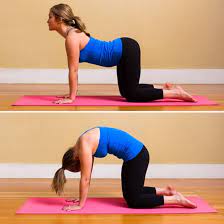
- Come onto your hands and knees with your weight balanced evenly between all four points
- Inhale to look up, dropping your abdomen down toward the ground as you extend your spine
- Exhale and arch your spine toward the ceiling and tuck your chin into your chest
- Continue this movement for at least 1 minute
Standing cat cow: Doing the cat cow stretch while standing helps to loosen up tightness in your back, hips, and glutes.
To do this:
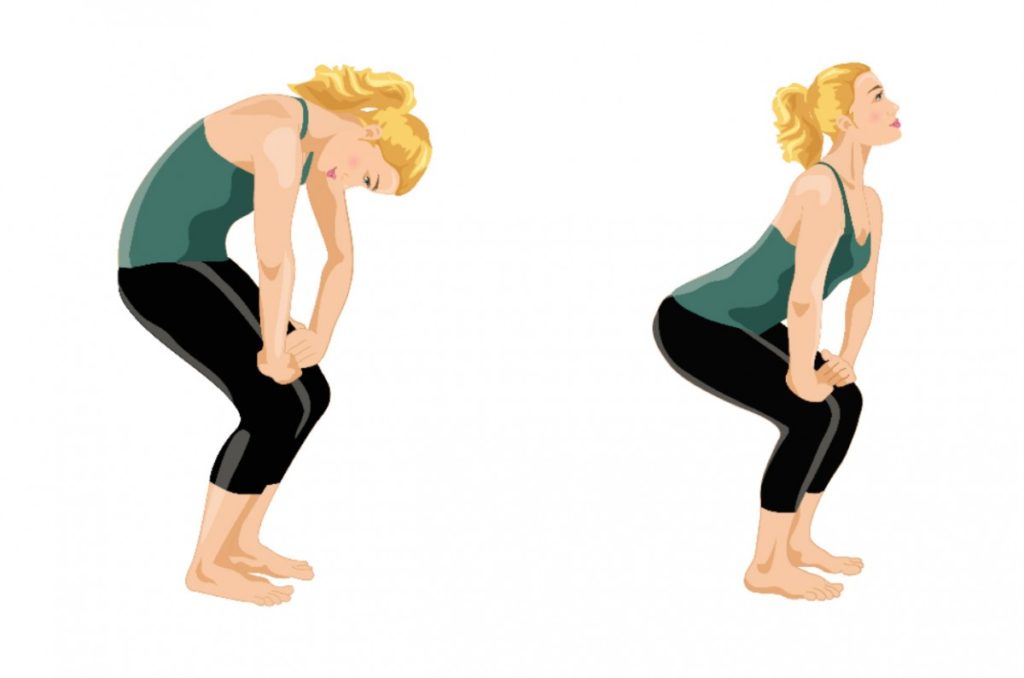
- Stand with your feet about hip-width apart with a slight bend in your knees
- Extend your hands in front of you or place them on your thighs
- Lengthen your neck, bring your chin toward your chest, and round your spine
- Then look up, lift your chest, and move your spine in the opposite direction
- Hold each position for 5 breaths at a time
- Continue this movement for a few minutes
Chest opener: This exercise allows you to open and stretch your chest. This is especially useful if you spend most of your day sitting, which tends to make your chest move inward. Strengthening your chest also helps you stand up straighter.
To do this:
- Stand with your feet about hip-width apart
- Bring your arms behind you and interlace your fingers with your palms pressing together. Grasp a towel if your hands don’t reach each other
- Keep your head, neck, and spine in one line as you gaze straight ahead
- Inhale as you lift your chest toward the ceiling and bring your hands toward the floor
- Breathe deeply as you hold this pose for 5 breaths
- Release and relax for a few breaths
- Repeat at least 10 times
High plank: The high plank pose helps to relieve pain and stiffness throughout your body while strengthening your shoulders, glutes, and hamstrings. It also helps you develop balance and strengthen your core and back, both important for good posture.
To do this:
- Come onto all fours and straighten your legs, lift your heels, and raise your hips
- Straighten your back and engage your abdominal, arm, and leg muscles
- Lengthen the back of your neck, soften your throat, and look down at the floor
- Make sure to keep your chest open and your shoulders back
- Hold this position for up to 1 minute at a time
Side plank: You can use a side plank to maintain the neutral alignment of your spine and legs. This energizing pose works the muscles in your sides and glutes. Strengthening and aligning these muscles helps to support your back and improve posture.
To do this:
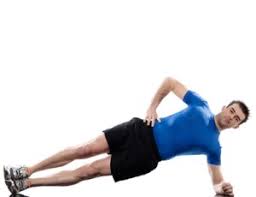
- From a high plank position, bring your left hand slightly into the center
- Shift your weight onto your left hand, stack your ankles, and lift your hips
- Place your right hand on your hip or extend it up toward the ceiling
- You can drop your left knee down to the floor for extra support
- Engage your abdominals, side body, and glutes as you maintain this pose
- Align your body in a straight line from the crown of your head to your heels
- Look straight ahead of you or up toward your hand
- Hold this pose for up to 30 seconds
- Repeat on the opposite side
Downward-facing dog: This is a forward bend that can be used as a resting pose to balance out your body. The downward-facing dog pose helps to relieve back pain, while also strengthening and aligning your back muscles. Practicing it regularly helps to improve posture.
To do this:
- Lying with your stomach on the floor, press into your hands as you tuck your toes under your feet and lift your heels
- Lift your knees and hips to bring your sitting bones up toward the ceiling
- Bend your knees slightly and lengthen your spine
- Keep your ears in line with your upper arms or tuck your chin all the way into your chest
- Press firmly into your hands and keep your heels slightly lifted
- Remain in this pose for up to 1 minute
Pigeon pose: This is a hip opener that also loosens up your spine, hamstrings, and glutes. The pigeon pose can also help to stretch your sciatic nerve and quadriceps. Opening and stretching these places in your body makes it easier to correct imbalances in your posture.
To do this:
- Come down on all fours with your knees below your hips and your hands a little bit in front of your shoulders
- Bend your right knee and place it behind your right wrist with your right foot angled out to the left
- Rest the outside of your right shin on the floor
- Slide your left leg back, straighten your knee, and rest your thigh on the floor
- Make sure your left leg extends straight back (and not to the side)
- Slowly lower your torso down to rest on your inner right thigh with your arms extended in front of you
- Hold this position for up to 1 minute
- Slowly release the position by walking your hands back toward your hips and lifting your torso
- Repeat on the left side
Thoracic spine rotation: This exercise relieves tightness and pain in your back while increasing stability and mobility.
To do this:
- Come onto all fours and sink your hips back down to your heels and rest on your shins
- Place your left hand behind your head with your elbow extended to the side
- Keep your right hand under your shoulder or bring it to center and rest on your forearm
- Exhale as you rotate your left elbow up toward the ceiling and stretch the front of your torso
- Take one long inhale and exhale in this position
- Release back down to the original position
- Repeat this movement 5 to 10 times
- Repeat on the opposite side
Glute squeezes: This exercise helps to strengthen and activate your glutes while relieving lower back pain. It also improves the functioning and alignment of your hips and pelvis, leading to better posture.
To do this:
- Lie on your back with your knees bent and your feet about hip-distance apart
- Keep your feet about a foot away from your hips
- Rest your arms alongside your body with your palms facing down
- Exhale as you bring your feet closer to your hips
- Hold this position for 10 seconds and then move them further away from your hips
- Continue this movement for 1 minute
- Do this exercise a few times per day
Isometric rows: This exercise helps to relieve pain and stiffness from sitting in one place for too long. Isometric pulls work your shoulder, arm, and back muscles, giving you the strength to maintain good posture.
To do this:
- Sit in a chair with a soft back
- Bend your arms so your fingers are facing forward and your palms are facing each other
- Exhale as you draw your elbows back into the chair behind you and squeeze your shoulder blades together
- Breathe deeply as you hold this position for 10 seconds
- On an inhale, slowly release to the starting position
- Repeat this movement for 1 minute
- Do this exercise several times throughout the day

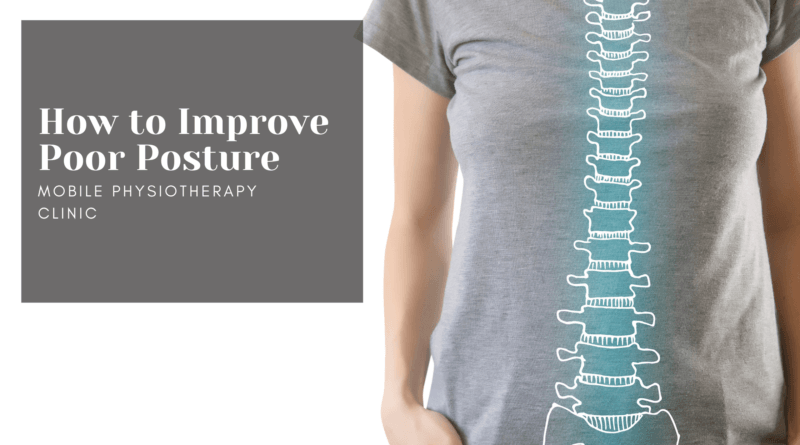

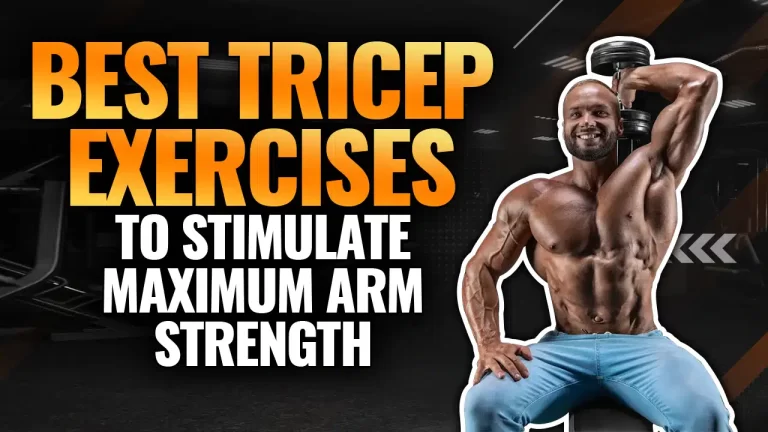
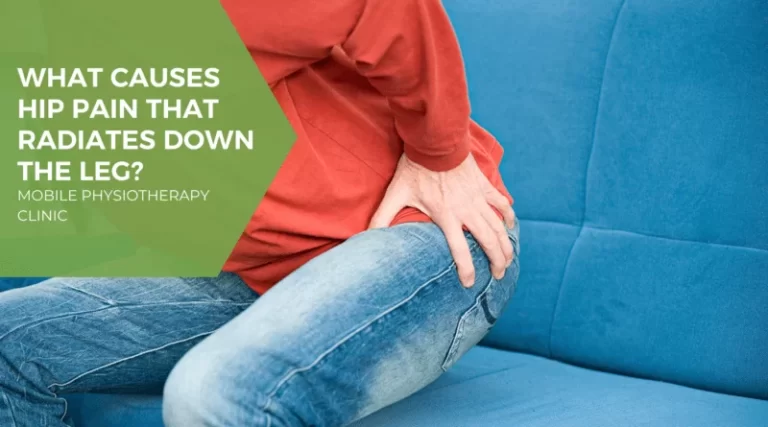
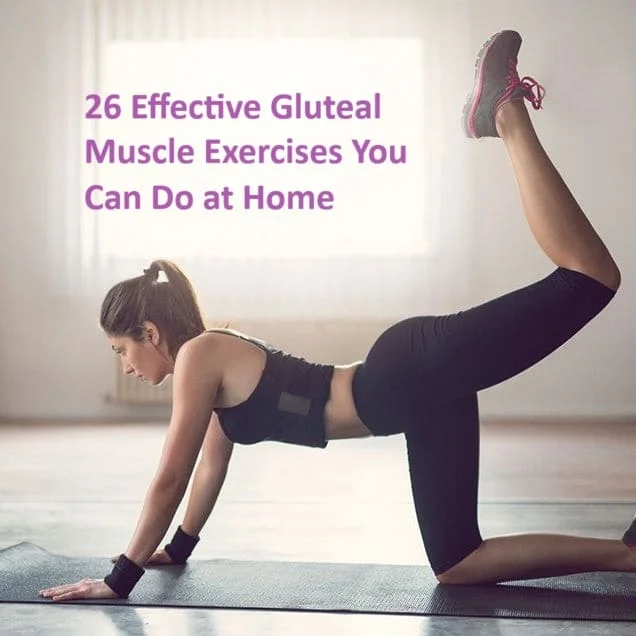
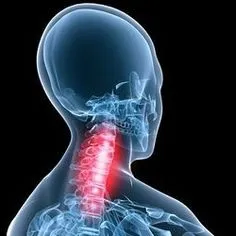
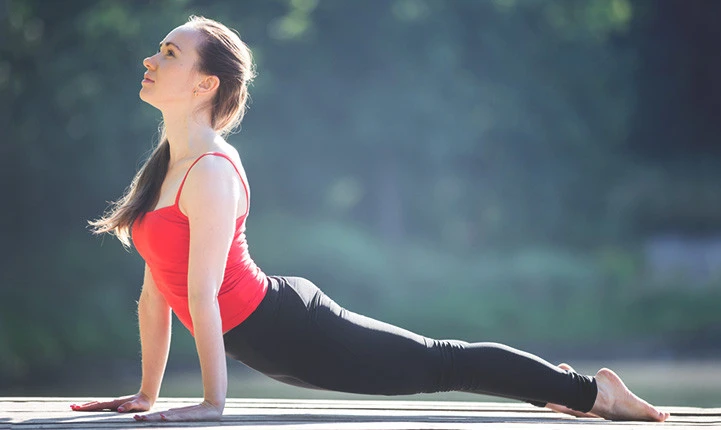
7 Comments